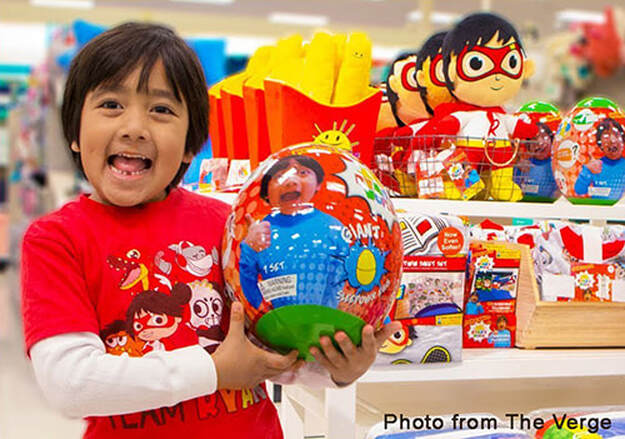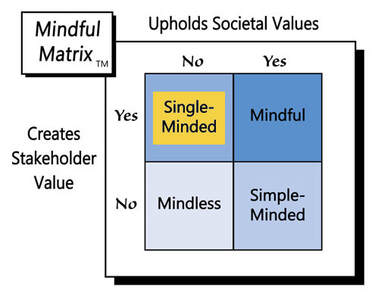Influencer marketing, or influence marketing, “is a form of social media marketing involving endorsements and product placements from influencers, people and organizations who possess an expert level of knowledge and/or social influence in their respective fields.”
Although influencer marketing has been around for ages with celebrities (movie stars, TV personalities, famous athletes, etc.) endorsing products, it’s different now because social media have democratized the process. Now anyone with a significant following on Instagram or other popular platform can become a paid product ambassador.
One of the most popular influencers is a 7-year old named Ryan Kaji who has an astounding 32.3 billion views on his YouTube channel Ryan Toy Review. His 21.7 million subscribers ‘tune in’ to watch him unpack and play with a wide variety of toys provided by sponsors such as Hasbro and Walmart.
However, Ryan’s YouTube channel is just part of his ever-expanding commercial influence. His parents also record Ryan and his younger siblings’ visits to commercial tourist attractions, like Legoland California, for Ryan’s Family Review. In addition, Ryan stars in a Nickelodeon cable and online series called Ryan’s Mystery Playdate. Other signs of his great popularity are branded products, including a “a Ryan Kaji action figure, T-shirts and a plastic dinnerware set.”
Ryan Kaji is far from the only “Kidfluencer”; however, and he’s not close to the youngest. For instance, a four-year old named Samia has over 203,000 YouTube subscribers and 143,000 followers on Instagram, where she attracts paid promotions from HomeStyle Harvest chicken nuggets and Crayola, among other brands.
Then there’s Kyle Fisher’s two-year-old identical twins, Taytum and Oakley, who have over 2 million Instagram followers. Advertisers like Mattel pay between $10,000 and $20,000 to sponsor a single post featuring Fisher’s daughters.
Of course, children have long been cast in commercials, which many of us older adults remember when we were kids. Who can forget young actor Tommy Okon asking Pittsburgh Steeler Mean Joe Greene, “Do you want my Coke?” There are some important differences, however, with today’s Kidfluencers.
First, the Internet is still like the ‘Wild West’ in terms ‘lawlessness.’ Thanks to the Federal Trade Commission (FTC), advertisers on television and radio must abide by rules that separate program content (the show) from commercial content (the ads) and that limit a character’s or program host’s use of promotions or product placement, but the Internet has no such restrictions.
So, there’s not much to stop the families of Kidfluencers from blurring the lines between programs and ads. Unlike when we watch traditional television that has distinct commercial breaks, online media often blend the two together such that influencers like Ryan Kaji are playing with and promoting sponsored products at the same time.
That blending leads to the second issue, mentioned above. Even adults can have a hard time distinguishing an unbiased product user from a paid endorser. Kids often have no concept that another child might only be playing with a toy online because his/her family received it for free or because they’re being paid to promote the product.
Children tend to take what they see and hear at face value. They’re unfamiliar with the notion of ulterior motives. As a result, kids can be easily misled.
I gained a sense of this vulnerability while teaching classes in Advertising Ethics for about a decade. Each year I was able to have my college students spend a little time talking with much younger students (sometimes just 4-6 years old) about advertising. Although the kindergarten-age kids could recognize almost any consumer-products brand from its logo, very few could explain what advertising was or why we had it.
Josh Golin, the executive director of the Campaign for a Commercial-Free Childhood, affirmed those observations by saying that it’s not until they’re 8 or 9 years old that most children recognize advertising. Similarly, in a complaint it filed against Ryan Toy Review, the nonprofit organization Truth in Advertising contended that preschoolers can’t differentiate an unbiased product review from a commercial.
Deception of young consumers isn’t the only potential ethical issue involving Kidfluencers. There’s the question of whether it’s right for parents to make their children promote products and whether such promotion constitutes work that might be subject to child labor laws.
But, back to the original issue: Although, Kidfluencers are very effective at ‘moving product,’ the deception used to accomplish those ends plays on the inexperience of some of society’s most vulnerable consumers--children. So, connecting the dots, the use of kids to influence the consumer behavior of other kids makes a picture of “Single-Minded Marketing.”
Learn more about the Mindful Matrix and Mindful Meter.
Check out Mindful Marketing Ads and Vote your Mind!




 RSS Feed
RSS Feed